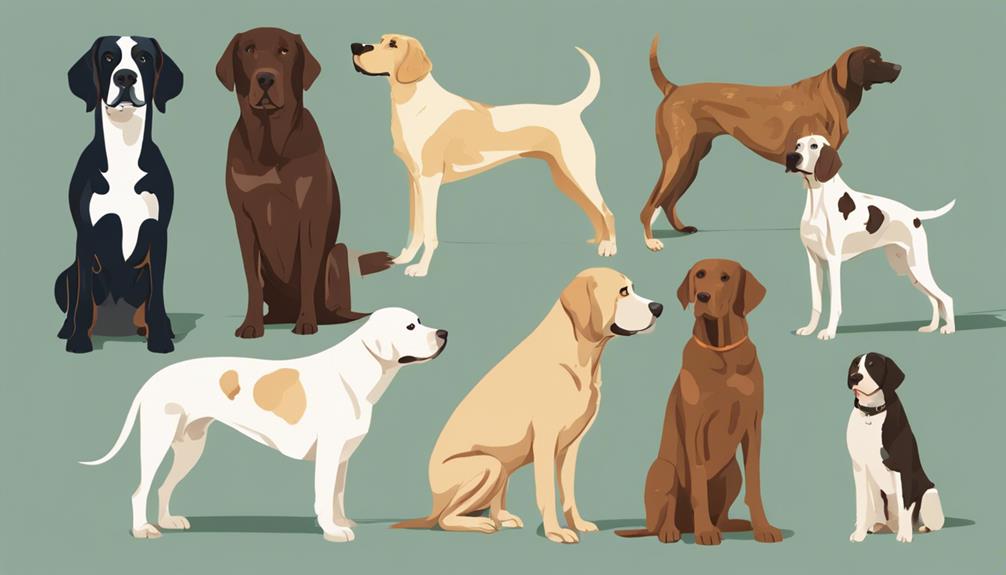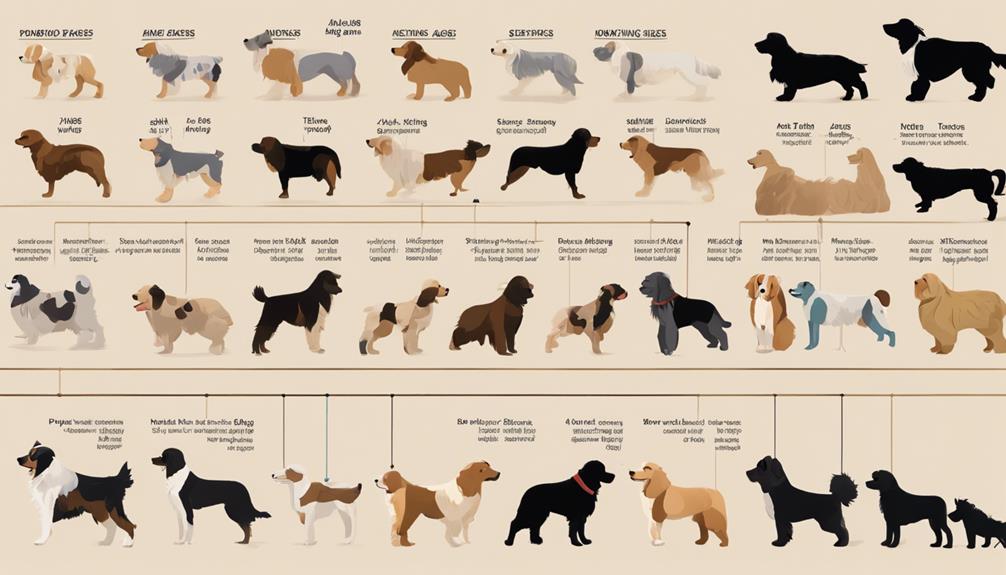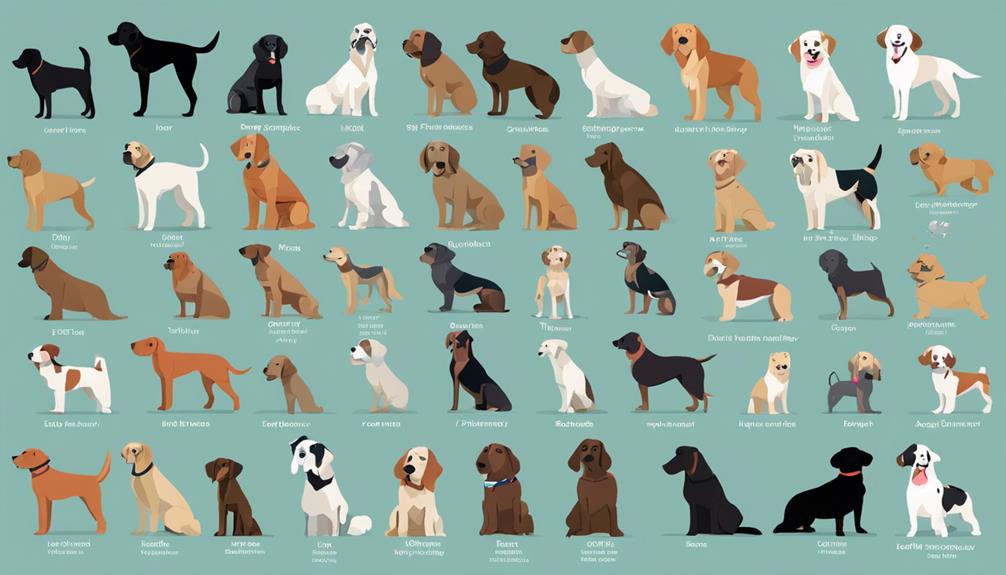13 Tips on Understanding Dog Breeds Life Expectancy
To understand dog breeds' life expectancy, prioritize balanced diet, regular exercise, and routine vet check-ups. Small breeds thrive with tailored nutrition, while moderate exercise benefits medium-sized dogs. Large breeds need strong muscles from a balanced diet and ample exercise. Toy breeds like Chihuahuas tend to live longer with proper care. Giant breeds require specific nutrition and regular vet visits. Mixed breeds may show signs of aging, needing attentive care. Purebreds have specific health tendencies, requiring tailored care. Sporting dogs need mental stimulation and balanced diet, while working dogs thrive with daily activities. Ensure a fulfilling life by prioritizing longevity tips.
Factors Affecting Dog's Lifespan
Understanding the factors that influence a dog's lifespan is crucial for responsible pet ownership. Factors influencing a dog's lifespan include both general factors that affect all dogs and breed-specific factors. General factors such as diet, exercise, genetics, and overall healthcare play a significant role in determining a dog's longevity. Ensuring your dog receives a balanced diet, regular exercise, and routine veterinary check-ups can greatly impact their lifespan.
Breed-specific factors also play a crucial role in determining how long a dog is expected to live. Different dog breeds have varying predispositions to certain health conditions that can affect their lifespan. For example, larger breeds tend to have shorter lifespans compared to smaller breeds. This is due to factors such as the rate at which they age, susceptibility to certain diseases, and potential joint issues that can arise in larger dogs.
Understanding these breed-specific factors can help you make informed decisions about your dog's care and anticipate any potential health issues that may arise as they age. By being aware of the factors that influence your dog's lifespan, you can take proactive steps to ensure they live a long, healthy, and happy life.
Small Dog Breeds' Longevity
Small dog breeds exhibit unique characteristics that contribute to their remarkable longevity compared to larger breeds. These little companions often live longer lives due to various factors that influence their overall health and well-being.
Here are some important insights into the longevity of small dog breeds:
- Regular Exercise: Small dog breeds may have high energy levels despite their size. Engaging them in regular physical activities helps maintain their overall health and weight, contributing to a longer lifespan.
- Proper Nutrition: Providing small dog breeds with a balanced diet suitable for their size and breed-specific needs is crucial for their longevity. High-quality food tailored to their requirements can support their immune system and overall vitality.
- Regular Veterinary Check-ups: Just like larger dogs, small breeds benefit from routine veterinary visits. Early detection of any health issues can lead to prompt treatment, ultimately enhancing their lifespan.
Medium Dog Breeds' Life Expectancy
Medium dog breeds' life expectancy is influenced by a combination of genetic factors, lifestyle choices, and healthcare practices. When considering the lifespan of medium-sized dogs, it's crucial to understand their exercise requirements and health considerations to help them lead long and healthy lives.
Medium-sized dog breeds typically require a moderate amount of exercise to stay fit and maintain their overall health. Regular physical activity, such as daily walks, playtime, and mental stimulation, is essential to prevent obesity and promote cardiovascular health. Engaging in interactive activities with your medium-sized dog not only strengthens your bond but also contributes to their overall well-being.
When it comes to health considerations, medium dog breeds may be prone to certain genetic conditions that can affect their longevity. Regular veterinary check-ups, proper nutrition, and preventive care, such as vaccinations and parasite control, are essential in ensuring your medium-sized dog stays healthy throughout their life. Being proactive about your dog's health can help detect any potential issues early on and provide timely interventions.
Large Dog Breeds' Aging Process
Exploring the aging process of large dog breeds reveals how factors like genetics, diet, and exercise impact their longevity and overall health. Large dog breeds, such as Great Danes, Mastiffs, and Saint Bernards, have specific characteristics that influence how they age gracefully.
To help you understand more about the aging process of large dog breeds, consider the following:
- Genetics: Large dog breeds are often prone to certain genetic conditions that can affect their lifespan. Understanding the breed-specific health concerns can help in providing appropriate care and early intervention.
- Diet: A balanced diet is crucial for large dog breeds to maintain a healthy weight and support their overall well-being. Proper nutrition plays a significant role in ensuring they age well and stay active as they grow older.
- Exercise: Regular exercise is essential for large dog breeds to keep their muscles strong, joints healthy, and weight in check. Adequate physical activity can also help in mental stimulation and prevent obesity-related issues.
Toy Dog Breeds' Life Span
When considering the life span of toy dog breeds, it's important to understand the unique factors that contribute to their longevity and overall health.
Toy dog breeds, being small in size, generally have a longer life expectancy compared to larger breeds. The average lifespan of toy dog breeds ranges from 12 to 16 years, with some living even longer.
Several factors play a crucial role in determining the longevity of toy dog breeds. Genetics, diet, exercise, and quality of healthcare are key lifespan factors. Toy breeds, such as Chihuahuas, Yorkshire Terriers, and Pomeranians, are known for their longevity when provided with proper care.
These small dog breeds often face specific health issues that can impact their lifespan. Conditions like dental problems, obesity, and joint issues are common among toy breeds and can affect their overall health and longevity. Regular veterinary check-ups, a balanced diet, and sufficient exercise are essential in promoting a healthy and long life for toy dog breeds.
Giant Dog Breeds' Longevity
Giant dog breeds typically have a shorter life expectancy compared to smaller breeds due to their rapid growth and larger size. This is an important factor to consider when choosing a giant breed dog as a pet.
To help you understand how to support the longevity of giant dog breeds, consider the following key points:
- Nutrition Requirements: Giant dog breeds have specific nutritional needs due to their size and growth rate. It's essential to provide them with a balanced diet that supports their bone and muscle development while also managing their weight to prevent obesity, which can lead to various health issues and shorten their lifespan.
- Exercise Needs: Giant dog breeds require regular exercise to stay healthy and maintain a good quality of life. Adequate physical activity helps prevent obesity, strengthens their muscles, and improves their overall well-being. Engaging in activities like long walks, playtime, and even swimming can help keep giant breeds fit and mentally stimulated.
- Regular Veterinary Check-ups: Due to their size and potential health concerns, regular veterinary check-ups are crucial for giant dog breeds. These check-ups can help detect any health issues early on, allowing for timely intervention and management to ensure a longer and healthier life for your beloved giant breed companion.
Mixed Breed Dogs' Aging

To understand the aging process of mixed breed dogs, it's essential to consider various factors that can impact their longevity and overall health. Mixed breed health is influenced by a combination of genetic traits inherited from different breeds, making it challenging to predict their specific aging patterns.
Aging in mutts is a unique journey that varies from one dog to another. While mixed breed dogs can inherit a diverse set of genes that may offer certain health advantages, they can also be prone to a wider range of health issues compared to purebred dogs. It's crucial for mixed breed owners to pay close attention to their dog's overall well-being and provide regular veterinary check-ups to monitor any age-related conditions.
As mixed breed dogs age, they may exhibit signs of slowing down, such as reduced energy levels, joint stiffness, and changes in appetite. Proper nutrition, regular exercise, and mental stimulation are essential components in promoting the longevity and quality of life for mixed breed dogs. By maintaining a healthy lifestyle and addressing any health concerns promptly, owners can help their mixed breed companions age gracefully and enjoy a fulfilling life together.
Purebred Dogs' Life Expectancy
As we shift our focus to Purebred Dogs' Life Expectancy, it's important to recognize that different purebred dog breeds exhibit varying lifespans due to their genetic predispositions and breed-specific health considerations.
- Genetic Predispositions: Purebred dogs often have specific genetic predispositions towards certain health conditions, which can impact their overall lifespan. It's essential to research and understand these breed-specific tendencies to provide appropriate care and early intervention.
- Health Care: Regular veterinary check-ups, vaccinations, and preventive measures are crucial for maintaining the health and extending the life expectancy of purebred dogs. Proper health care can help in early detection of potential issues, ensuring prompt treatment.
- Exercise Requirements and Diet Restrictions: Each purebred dog breed has unique exercise needs and dietary requirements. Meeting these needs adequately is vital for their overall well-being and longevity. Regular exercise helps in maintaining their physical health, while a balanced diet tailored to the breed's specific nutritional needs can contribute to a longer and healthier life.
Understanding the intricacies of purebred dogs' life expectancy involves a combination of genetic factors, health care practices, exercise routines, and dietary considerations. By being aware of these elements and providing appropriate care, you can help ensure a fulfilling and extended life for your purebred canine companion.
Sporting Dog Breeds' Longevity

Sporting dog breeds, known for their athleticism and hunting abilities, often exhibit impressive longevity due to their active lifestyle and robust health. These breeds, such as the Labrador Retriever, Golden Retriever, and English Springer Spaniel, require regular exercise to maintain their physical and mental well-being. Meeting sporting dog breeds' exercise needs is crucial for ensuring they lead long, healthy lives.
To increase the lifespan of sporting dog breeds, consider the following tips:
- Regular Exercise: Engage your sporting dog in activities that match their energy levels. Activities like running, swimming, and playing fetch help them stay fit and happy.
- Balanced Diet: Provide a well-balanced diet that meets their nutritional requirements. Consult with your veterinarian to determine the best diet for your specific breed.
- Routine Veterinary Care: Schedule regular check-ups to monitor your dog's health and catch any potential issues early.
- Mental Stimulation: Keep your sporting dog mentally stimulated with interactive toys, training sessions, and new experiences to prevent boredom and behavioral problems.
- Maintain a Healthy Weight: Obesity can shorten a dog's lifespan. Monitor your dog's weight and adjust their diet and exercise regimen as needed.
Working Dog Breeds' Life Span
Working dog breeds, known for their intelligence and versatility in various tasks, also exhibit notable longevity attributed to their strong work ethic and physical robustness. These breeds are often bred for specific jobs and excel in roles such as search and rescue, police work, and assistance tasks.
Here are some key factors that contribute to the longer life spans of working dog breeds:
- Regular Exercise: Working dogs are typically engaged in daily physical activities, which help maintain their overall health and fitness levels.
- Mental Stimulation: These breeds thrive on mental challenges, such as agility competitions, obedience training, and working dog training, which keep their minds sharp and active.
- Quality Nutrition: Proper diet and nutrition play a crucial role in extending the life expectancy of working dogs, ensuring they receive the necessary nutrients to support their active lifestyles.
Herding Dog Breeds' Aging Process

In understanding the aging process of herding dog breeds, it's essential to recognize the unique characteristics and tendencies that contribute to their longevity and overall well-being. Herding dog breeds, known for their intelligence and energy, require regular exercise to maintain their physical and mental health. Daily walks, interactive play sessions, and engaging activities are crucial to meeting herding dog breeds' exercise needs. Providing them with enough physical and mental stimulation can help prevent behavioral issues and keep them happy as they age.
Moreover, herding dog breeds have specific grooming requirements that shouldn't be overlooked. Their coats vary in length and texture, necessitating regular brushing and grooming to prevent matting and keep their skin healthy. Developing a grooming routine early on and sticking to it can contribute to the overall well-being of herding dog breeds as they get older.
In terms of temperament, herding dog breeds are known for their loyalty, intelligence, and strong work ethic. When it comes to training, consistency, positive reinforcement, and mental challenges are key. Keeping training sessions interesting and varied can help maintain their focus and prevent boredom. Mental stimulation through obedience training, agility exercises, or puzzle games can also help keep their minds sharp and agile as they age.
Terrier Dog Breeds' Life Span
When considering the life span of terrier dog breeds, it's important to recognize their unique characteristics and factors that influence their longevity. Terriers are known for their spirited personalities, distinctive wiry coats, and varying sizes, all of which can impact their health and lifespan.
Here are some key points to understand about terrier breeds:
- Terrier breeds' health concerns: Terriers are generally robust dogs, but they can be prone to certain health issues such as allergies, luxating patella, and Legg-Calve-Perthes disease. Regular veterinary check-ups and a balanced diet are essential in ensuring a terrier's well-being and longevity.
- Terrier breeds' exercise requirements: Terriers are an active group of dogs that require regular exercise to stay healthy and happy. Engaging in activities like brisk walks, interactive play sessions, and even some agility training can help fulfill their exercise needs and prevent boredom-related behavior issues.
- Training and mental stimulation: Terriers are intelligent and independent dogs that benefit from mental stimulation and training. Providing them with obedience training, puzzle toys, and interactive games can help keep their minds sharp and prevent behavioral problems.
Understanding these aspects of terrier breeds can help you provide the best care for your furry companion and potentially increase their life expectancy.
Non-Sporting Dog Breeds' Longevity

To assess the longevity of non-sporting dog breeds, one must consider various factors that influence their lifespan and overall health. When it comes to the longest-living non-sporting breeds, the Dalmatian and the Lhasa Apso are among those known for their extended lifespans. These breeds can often live up to 14-16 years with proper care and attention.
Health tips for non-sporting breeds are crucial in ensuring a long and healthy life for your furry companion. Regular exercise is essential for preventing obesity, which can lead to various health issues and reduce your dog's lifespan. Non-sporting breeds may not have the same exercise requirements as sporting breeds, but they still need daily walks and playtime to stay active and maintain a healthy weight.
In addition to exercise, a balanced diet tailored to your dog's specific needs is key to promoting longevity. Non-sporting breeds like Bulldogs and French Bulldogs are prone to obesity, so it's important to feed them high-quality food in the right portions to prevent weight-related health issues.
Regular visits to the veterinarian for check-ups and vaccinations are also vital for maintaining your non-sporting dog's health. Early detection of any potential health problems can lead to better outcomes and a longer, happier life for your beloved pet. By following these health tips and providing your non-sporting breed with love and care, you can help them live a long and fulfilling life.
Frequently Asked Questions
Do Emotional Support or Therapy Dogs Have a Longer Life Expectancy?
Emotional support or therapy dogs don't inherently have a longer life expectancy compared to other dogs. Their well-being is influenced by factors like genetics, environment, and the quality of care they receive.
However, the strong emotional bond formed between these dogs and their owners can positively impact their overall health and longevity. Providing companionship and support can create a fulfilling and enriched life for these special dogs, potentially contributing to a longer lifespan.
How Does a Dog's Activity Level Impact Its Lifespan?
To understand how a dog's activity level affects its lifespan, consider its exercise habits. Dogs with higher energy levels often need more physical activity to stay healthy. Regular exercise can contribute to a longer life for your furry friend.
Can a Dog's Diet and Nutrition Affect Its Longevity?
Eating a well-balanced diet is crucial for your furry friend's longevity. Nutritional requirements vary among dog breeds but play a significant role in their overall health and lifespan.
Providing high-quality food tailored to your dog's specific needs can help prevent certain health issues and promote a longer, healthier life. Consider consulting with a veterinarian to ensure your dog's diet meets their nutritional needs and supports their longevity factors.
Are There Specific Environmental Factors That Can Influence a Dog's Lifespan?
Specific environmental factors, such as climate conditions and genetics, can significantly impact a dog's lifespan. Providing appropriate exercise habits and promoting socialization also play crucial roles in determining a dog's longevity.
It's essential to create a healthy environment that supports your dog's overall well-being to ensure a longer and happier life. By considering these factors, you can positively influence your furry friend's lifespan.
What Role Does Regular Veterinary Care Play in Extending a Dog's Life Expectancy?
Regular veterinary care plays a crucial role in extending your dog's life expectancy. Through regular check-ups and preventative care, potential health issues can be identified early on, leading to timely interventions.
Additionally, veterinarians can provide guidance on exercise benefits and help you manage any health risks your dog may face. By staying proactive with your dog's health and following your vet's recommendations, you can significantly improve your furry friend's quality and length of life.
Conclusion
Understanding the life expectancy of different dog breeds is crucial for providing them with the best care possible. Factors such as size, breed type, and genetics all play a role in determining how long our furry companions will be with us.
By being informed about these factors, you can better prepare for your dog's aging process and ensure they live a long and happy life. Remember, each dog is unique, so consult with a veterinarian for personalized guidance on your dog's specific needs.
